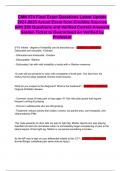CMN 574 Final Exam Questions Latest Update
2024-2025 Actual Exam from Credible Sources
with 250 Questions and Verified Correct Answers
Golden Ticket to Guaranteed A+ Verified by
Professor
(FYI) Infants - degree of instability can be described as: - CORRECT ANSWER: -
Dislocated and reducible: +Ortolani
- Dislocated and irreducible: -Ortolani
- Dislocatable: +Barlow
- Subluxated: hip with mild instability or laxity with a -Barlow maneuver
12-year-old boy presents to clinic with complaints of knee pain. You elicit from his
history that he plays baseball. Denies recent trauma.
What do you suspect is the diagnosis? What is the treatment? - CORRECT ANSWER:
Osgood-Schlatter disease
- Common cause of knee pain in boys ages 10-15yr who play sports that require
frequent running & jumping
- Occurs in adolescents who are still growing
- Treatment: reduce activity that makes it worse, ice painful area, use kneepads, anti-
inflammatories PRN
13yr male presents to clinic with c/o pain to right leg. Mother reports son was playing
baseball and slid into homebase when he immediately began complaining of pain to the
lateral aspect of that right leg. Mother is concerned something is broken.
As the NP was is high on your differential related to this CC? - CORRECT ANSWER:
Burner/Stinger (unilateral pain same side as injury).
,Tx: remove from play and observe
2 mo female presents with mom to clinic for wellness exam. Upon exam, you note
infants head is turned towards the left. You educate mom that with passive stretching,
torticollis can be corrected.
When dictating your findings following the visit, you note this to be right or left torticollis?
- CORRECT ANSWER: right-sided torticollis
2 yr. old presents to clinic with mother for wellness exam. Following vitals, you ask mom
to place patient on exam table for the physical exam portion of the visit. You note the
child to walk towards the table with knees turned inward during ambulation.
What is your preliminary dx? What age is this considered normal? - CORRECT
ANSWER: Genum valgum
Until 8 yr. old - then, refer to ortho
32y female presents to clinic with c/o chest pain, intermittent. Associated symptoms
include generalized fatigue. Vitals: 92hr, 100% room air. Physical exam reveals pale
conjunctiva.
Based on your findings, how would you proceed? - CORRECT ANSWER: Suspect iron-
deficiency anemia.
Labs: CBC + iron studies
Treatment: iron supplement
Education: Increase daily fiber and water intake
Follow-up: 1 month to recheck labs.
36y Caucasian male presents to ER for chest pain noted to left chest radiating down left
arm. Labs: 1.76 trop, BNP 56, BUN 32, Cr 0.9, Na 147, K 4.2, CK 9600, UA amber-
colored, SG 1.071.
,What do you suspect in this patient? - CORRECT ANSWER: Possible acute MI (need
EKG),
Rhabdomyolysis (high CK), due to age - possible cocaine use, Elevated BUN/Normal
Cr, amber-colored urine, elevated SG (dehydration).
5mo infant brought to clinic by mother who states child will not move left arm. HPI: child
was brought to daycare this AM, laughing and playing as normal. Mother picked child up
around 530pm and when placing child in carseat, child cried anytime the left arm was
moved. Upon assessment of this child, you note child refuses to use left arm, with left
elbow slightly flexed, forearm pronated.
What diagnosis do you suspect?
From this injury what anatomical abnormality occurs?
What additional findings on physical exam would add to your differential?
What further testing should be obtained? - CORRECT ANSWER: Nursemaids elbow
Subluxation of the annular ligament r/t sudden longitudinal traction applied
to hand
Radial head tenderness (pain to lateral aspect of elbow)
None - XR not required in setting of classic presentation (hx of traction injury, child <5yr,
consistent clinical exam) - however, when you obtain XR they are normal.
62 yr. old male presents to clinic with c/o stiffness to shoulders, onset this episode 4
days ago. Duration - occurring for over 3 years now, intermittently. Pt has been
managing at home with OTC meds (Tylenol / ibuprofen) with relief at times, but today
something was different. Pt states this morning, he woke up with a headache and blurry
vision. Pt states he tried cold compresses to the back of his neck and massaging his
head for relief - but that only resulted in more pain.
, What is your NEXT action as the NP? - CORRECT ANSWER: STAT transfer to ED
Suspect Giant Cell arteritis (>50y, tender scalp, visual changes)
Requires high-dose IV prednisone and optho consult
6yr male patient presents to clinic with clavicle fracture. HPI notes no recent trauma or
fall. What causes need to be a part of your differential? Select all that apply:
A: Tumor
B: Rickets
C: Osteogenesis imperfecta
D: Physical Abuse - CORRECT ANSWER: A, B, C, D
6yr old patient presents to clinic with mother for wellness exam. This patient is new to
you, however - not new to the clinic. Upon review of the patient's chart, you note your
partner in the clinic had not yet reviewed imaging results scanned in last week. The
Xray reports was as follows: "medial deviation forefoot with plantar flexion at the ankle
joint."
You note this to be a finding of what? - CORRECT ANSWER: Talipes equinovarus -
clubfoot
7y male presents to ER c/o severe pain to right knee s/p tackle during football game.
Upon exam, you note knee is partly bent, moderate swelling with a lump noted to lateral
side of knee. +Pain with palpation.
What is this patient's diagnosis? What is the appropriate XR order and what do you
expect to find? What is the treatment? - CORRECT ANSWER: Patellar dislocation
XR: sunrise view - demonstrate lateral dislocation of patella. NOTE: carefully evaluate
Xray for presence of osteochondral fragments displaced within the knee joint.




